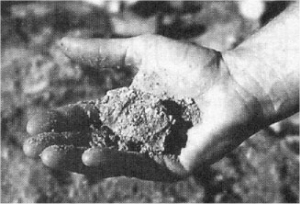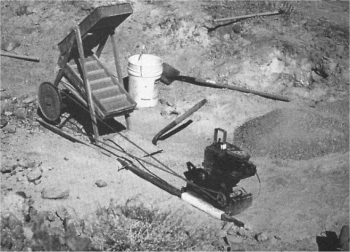By Sam Radding
How to Determine what “Good Gold” Means to You
 The meaning of “Good Gold” is a matter of perspective and experience. This phrase is generally used in terms of quantity and ease of extraction. A couple of old-timers, sitting around the fire talking gold, will often have enough shared-experiences to know what the other means by “good.”
The meaning of “Good Gold” is a matter of perspective and experience. This phrase is generally used in terms of quantity and ease of extraction. A couple of old-timers, sitting around the fire talking gold, will often have enough shared-experiences to know what the other means by “good.”
“This soil is very damp.”
The captivating nature of gold brings out different emotional responses from each of us.
The problem lies in the fact that just about every novice miner starts with little or no knowledge of the realities in the activity of gold prospecting. Our story may serve to shed some light on what to expect from your own first few mining trips.
Jean and I live in San Diego. To start with, our part of the country is very dry. So, a lot of the gold hunting is accomplished using a dry-washer. There are a few placer areas within an hour’s drive of our house, but they have very limited access and the gold tends to be pretty sparse. We tried some gold panning and found a few specks of gold; but from what we could determine from the local prospector’s club and friends, the Pot Holes would be a better-than-average place to start. This area is about a three-hour drive from San Diego, and is near Yuma, Arizona, but still in California.
 Building a workable dry-washer would be a snap. I have always been good at figuring out how machines work and how they should be constructed. Ten minutes with a friends’ bellows dry-washer was enough to get me started on our own machine. A few days later, we were packed and driving to the desert with our newly-built dry-washer and an old 3-horsepower Briggs and Stratton engine. I just had to test my new creation. When it comes to gold, to me, now is always better than later.
Building a workable dry-washer would be a snap. I have always been good at figuring out how machines work and how they should be constructed. Ten minutes with a friends’ bellows dry-washer was enough to get me started on our own machine. A few days later, we were packed and driving to the desert with our newly-built dry-washer and an old 3-horsepower Briggs and Stratton engine. I just had to test my new creation. When it comes to gold, to me, now is always better than later.
Our maps were good, so we had no trouble finding the bridge across the American Canal along with the road to the open recreational mining area just southwest of the old 3 C’s mine. The road in had a few rough spots, but nothing that our little Vega station wagon (with three-inch ground clearance) could not make. By the way, this location still remains open to anyone; and to this day, it is still productive.
The big problem was where to start. Book gold is a lot different than real gold. The books we read were small and the maps and locations where gold would be trapped seemed fairly straight forward. The Pot Holes was huge; and of course, we wanted to work in the best spots. We wanted to find some “Good Gold!” I had read several articles about the importance of prospecting and sampling before you decide to invest the bulk of your resources to any particular area.
Jean and I do argue on occasion; and as it turned out, picking-out our first dry-washing spot was a perfect time to disagree (Thirteen years later, so we can minimize disagreements, we now have two of almost all the equipment we use.). After about fifteen minutes, we jointly settled on a small wash. There were a few tree roots and some exposed bedrock to work. This wash was about a hundred yards from where we parked the car. After packing our gear to the site, we set the engine and dry-washer in place; with the engine upwind to keep it free from the dust generated by our dry-washer. Then, with the dry-washer delivering about 90 beats per minute (possibly a little fast for the conditions we were working), we proceeded to dig and feed gravel to the dry-washer for about a half-hour. We had brought along some water for the purpose, so we practically ran back to the Vega to pan our concentrates. Much to our surprise, we had almost no gold. We just had some small specks.
Our next spot was just down from where our first little wash emptied into a slightly larger dry-wash. The opposite bank looked good to me. There was some exposed bedrock, and the overburden was only about a foot deep. The digging was very easy; and after an hour, we decided once again to check our progress. I was impressed this time. There were lots of little flakes. Jean was not so favorably-disposed. It still looked like specks to her; and after a short time, it began to look that way to me, too. Another move seemed to be in order. We spent the next two and a half days moving from place to place, from specks of gold, to specks of gold.
Jean was getting a little frazzled, and I was getting more and more frustrated. I wanted to go back to the place that impressed me on the first day. The bank on the small wash gave up about 1 pennyweight (about l/20th of an ounce) of gold in an hour, even if they were only small specks. To us, it did not look like very much gold and I didn’t know if it was good or bad; but that spot seemed far better than the other places we had dry-washed during the past few days. I really wanted to go back.
Jean went back to camp to make lunch and I picked up the dry-washer, engine and the pick and shovel and started off to my spot. After about ten steps, I heard a rumble. My first thought was that it couldn’t be thunder, not here. A quick glance over to the west set me straight. Over my head, it was sunny and blue. A few miles away, it was dark, very dark. Even I knew that it was impossible to dry-wash in wet material.
The thunderstorm might move the other direction. But at worst, I would have a little time to work. I hobbled to my spot, carrying over 75 pounds of gear and equipment, and quickly set up the dry-washer and engine. If it was going to rain, then I was going to shovel as much material through the dry-washer as it would take. I worked hard as the storm crept closer. The first big drops of rain arrived about an hour later. Ten minutes after that, our dry-washing was finished for this trip. I had kept the riffle tray dry as I had been told. Dust and moisture in the riffle tray cloth create cement, and that combination will not pass air. No air means no gold; which in turn, means stretching a new cloth for the dry-washer.
Everything else was wet. We panned-out my concentrates, and our total gold for the trip filled a two-pennyweight vial and half of another. We had over 3 pennyweights, most which came in two hours of dry-washing at my spot. It still looked like specks, but there sure were a lot of them. Our problem was that we had no yardstick by which to judge “Good Gold.” Back home, we told some mining friends about our spot in some detail and about how we had done. We thought there might be some more gold there and we were going back in a couple of weeks, after things had dried out a bit. Our more-experienced friends were impressed when we showed them our gold from our very first prospecting trip.
If you have never dry-washed, you must remember that any moisture in the pay-dirt will make any dry-washer less efficient. An easy way to check for water-content is to squeeze a handful of your pay-dirt into a ball. Then open your hand. If the ball falls apart, the material is very dry. If the ball breaks into several smaller sections and tends to crumble, you are working with slightly-damp material. Most dry-washers will run this material, but the efficiency will be diminished somewhat. If the ball stays intact or breaks into two or three parts, the pay-dirt must be dried before running through the dry-washer. On a good day, most dry-washers will lose between 10% and 20% of the finer-sized gold which remains trapped in small dirt balls. They pass right through the machine!
When we got back to our spot three weeks later, the site had already been cleaned out. We did get a little more gold, but we later found out that a few of our more-experienced friends went in there before us and recovered about two ounces of gold during our absence. From that time forward, both Jean and I had a little better understanding of what the term “Good Gold” means!
To this day, I still have a hard time keeping my mouth shut when it comes to where we are working and what we are finding. Most gold prospectors that we meet find this an endearing, if not a foolish, trait to have. I am getting the idea that when it comes to gold, you have to be careful how you conduct your business affairs!
If you are just starting out, whether you are working on a river, stream or in the desert, or whether you are using a dry-washer, sluicing system or four-inch dredge, recovering a pennyweight of gold an hour is making “Good Gold.” Two-to-five pennyweights in a day’s work is fairly good for small equipment. I personally average a little over two pennyweights per day when I am sniping (finding gold with hand tools and a face mask) on my favorite rivers in the Mother Lode area.
Over the years, I have built over a hundred dry-washers, both the bellows and constant-air types. I have written books on the home-construction of small-scale mining equipment. Jean and I spend most of every summer looking for gold. More gold is always better than less gold; but to me, I feel I have done well if my final clean-up produces over two pennyweights in a day. This is my personal yardstick for how I am doing. The amount of gold we find is important, but we are also enjoying what we are doing.
Here is where you can buy a sample of natural gold.
- Here is where you can buy Gold Prospecting Equipment & Supplies.
- More articles about dry-washing
- More about how to prospect for gold
- More gold mining adventures
- Schedule of upcoming events
- Books and Videos by Dave McCracken.





